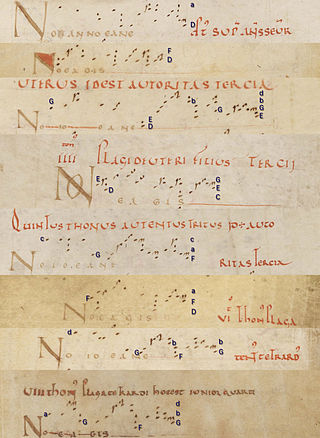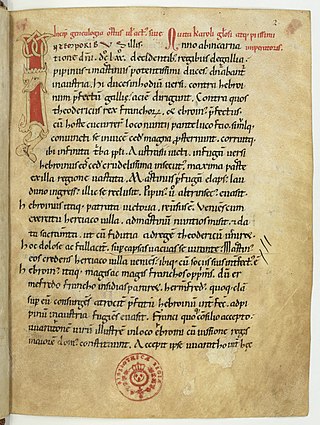
Martial, called "the Apostle of the Gauls" or "the Apostle of Aquitaine", was the first bishop of Limoges. Venerated as a Christian Saint, his feast day is 30 June.

Adémar de Chabannes was a French/Frankish monk, active as a composer, scribe, historian, poet, grammarian and literary forger. He was associated with the Abbey of Saint Martial, Limoges, where he was a central figure in the Saint Martial school, an important center of early medieval music. Much of his career was spent copying and transcribing earlier accounts of Frankish history; his major work was the Chronicon Aquitanicum et Francicum.
Geoffroy du Breuil of Vigeois was a 12th-century French chronicler, trained at the Benedictine abbey of Saint-Martial of Limoges, the site of a great early library. Geoffroy became abbot at Vigeois (1170–1184) where he composed his Chroniques which trace in detail some great local families, often Geoffroy's forebears and kin, while relating events happening from 994 to 1184: the fiery convulsive sickness,, the preparations for the First Crusade, reports of combats in the Holy Land, the spread of Cathar beliefs, all the while unconsciously revealing the preoccupations and manners of the times.

Froissart's Chronicles are a prose history of the Hundred Years' War written in the 14th century by Jean Froissart. The Chronicles open with the events leading up to the deposition of Edward II in 1327, and cover the period up to 1400, recounting events in western Europe, mainly in England, France, Scotland, the Low Countries and the Iberian Peninsula, although at times also mentioning other countries and regions such as Italy, Germany, Ireland, the Balkans, Cyprus, Turkey and North Africa.
The Saint Martial School was a medieval school of music composition centered in the Abbey of Saint Martial, Limoges, France. Most active from the 9th to 12th centuries, some scholars describe its practices, music, and manuscripts as 'Aquitanian'. It is known for the composition of tropes, sequences, and early organum. In this respect, it was an important precursor to the Notre Dame School. Adémar de Chabannes and his uncle Roger de Chabannes who introduced Adémar in the craftship of a notating cantor, were important proponents of this school whose hands had only be recently discovered by studies of James Grier between 1995 and 2005. They invented a local variant of a vertically precise organisation of notation and a new form of local tonary, they reorganised existing chant manuscripts, and they developed the libellum structure of a new type of sequentiary troper whose organisation was new at their time, but played a key role for the Saint Martial school.

The Diocese of Limoges is a Latin Church diocese of the Catholic Church in France. The diocese comprises the départments of Haute-Vienne and Creuse. After the Concordat of 1801, the See of Limoges lost twenty-four parishes from the district of Nontron which were annexed to the Diocese of Périgueux, and forty-four from the district of Confolens, transferred to the Diocese of Angoulême; but until 1822 it included the entire ancient Diocese of Tulle, when the latter was reorganized.

The Grandes Chroniques de France is a vernacular royal compilation of the history of the Kingdom of France, most manuscripts of which are luxury copies that are heavily illuminated. Copies were produced between the thirteenth and fifteenth centuries, the text being extended at intervals to cover recent events. It was first compiled in the reign of Saint Louis, who wished to preserve the history of the Franks, from the coming of the Trojans to his own time, in an official chronography whose dissemination was tightly controlled. It was continued under his successors until completed in 1461. It covers the Merovingian, Carolingian, and Capetian dynasties of French kings, with illustrations depicting personages and events from virtually all their reigns.

The Abbey of Saint Martial was a monastery in Limoges, France, founded in 848 and dissolved in 1791.
A tonary is a liturgical book in the Western Christian Church which lists by incipit various items of Gregorian chant according to the Gregorian mode (tonus) of their melodies within the eight-mode system. Tonaries often include Office antiphons, the mode of which determines the recitation formula for the accompanying text, but a tonary may also or instead list responsories or Mass chants not associated with formulaic recitation. Although some tonaries are stand-alone works, they were frequently used as an appendix to other liturgical books such as antiphonaries, graduals, tropers, and prosers, and are often included in collections of musical treatises.
Guillaume de Nangis, also known as William of Nangis, was a French chronicler.
The Chronicon Aquitanicum is a set of annals covering the years 830 to 930 with several gaps and an added notice on the year 1025. It is found in the "great encyclopedia codex", BN lat. 5239, of the Abbey of Saint Martial at Limoges. Its entries are annotations on an Easter cycle.

The Annals of Vendôme are a set of medieval annals covering events from 678 to 1347. They survive in a single manuscript copy, the exemplar of which came from the Abbey of the Holy Trinity at Vendôme.
The Chronicle of Saint-Pierre-le-Vif of Sens is an anonymous Latin chronicle written at the Abbey of Saint-Pierre-le-Vif in Sens between about 1100 and 1125 with continuations added into the 13th century. The original work was attributed to a monk named Clarius by Dom Victor Cottron in 1650, but this is not now accepted. It is, however, sometimes still labeled the Chronique dite de Clarius. The Chronicle is mainly a history of the abbey and of the city of Sens.
The Miracula Martialis is a collection of miracle reports written in Latin. It is the earliest collection of miracles purportedly worked through the intervention of Saint Martial, a 3rd-century bishop of Limoges, and a key piece of his then still growing hagiography. It was initially compiled in the late 7th or early 8th century and expanded once shortly after 832 and again shortly after 854. The oldest miracles it records took place in the 7th century.

Primat was a French Benedictine monk and historian of the abbey of Saint-Denis near Paris. He composed two histories of France with a royal focus, one in Latin and the other in Old French. His Latin chronicle covers the years 1248 to 1277 but now survives only in an Old French translation and in excerpts incorporated into the works of others. It contains a detailed account of the reign of Louis IX, making it one of the most important contemporary sources for that reign. His French chronicle, the Roman des rois, covers the entire history of France down to 1223. It was completed around 1274 for Philip III and its presentation copy is extant. It is the earliest version of what would become the Grandes Chroniques de France, the first official history of France.

Bernard Itier (1163–1225) was a French Benedictine monk, librarian, copyist and chronicler at the abbey of Saint Martial in Limoges.
Gaston Raynaud was a French philologist and librarian.

The Chronicle of Aniane is an anonymous Latin history covering the rise of the Carolingian family from 670 to 840. It was composed by a monk of the Abbey of Aniane (Hérault).
Pierre Coral was a French monk and historian. He was the prior of Saint-Martin de Limoges, then abbot from 1247 until 28 August 1276, when he became the abbot of Tulle, a position he held until his death. He was buried in Tulle next to the altar of Saint Martin.

Saint-Martin de Limoges was a Benedictine monastery in Limoges from 1012 and a house of Feuillants from 1624 until 1791.